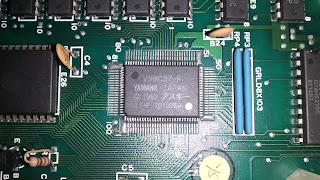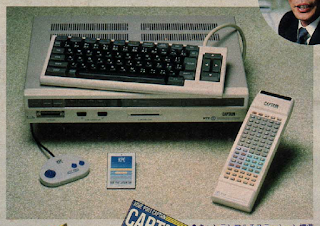The design of the two known MSX from Takaoka are very similar. Almost the same color palette (tedious beige) and structure. Until the NTT machine's arrival, I guessed the two metal boxes are the same, which is not true, one is a bit wider and lower than the other, and the NTT CAPTAIN Multi-Station have more internal structures holding the cabinet together.
 |
| Top: NTT CAPTAIN Multi-Station, Bottom: AUCNET NIA-2001 |
 |
| Behind that small metal plate there is a lot of DIP switches. |
And what's inside NTT CAPTAIN Multi-Station?
Like the external design, the insides of the two MSXs from Takaoka are very similar.
 |
| AUCNET NIA-2001 internals: one big mother-board, MSX slots connected by flat cables, a video daughter-board and modem daughter-board. |
 |
| NTT CAPTAIN Multi-Station internals: one big mother-board, MSX slots connected by flat cables, a video daughter-board and modem daughter board. |
The mainboard is the MSX computer, only the RF modulator and video outputs are in the video daughter board. The modem card is... a modem. So far I do not know how it is seen by MSX. The machine turn on and goes to CAPTAIN menu, even when the modem is not connected to the mainboard.
NTT CAPTAIN Multi-Station uses a Sharp LH0080A (Z80 compatible) as main CPU, the PPI/PSG/etc are integrated in the MSX-SystemII (S1985 from Yamaha) and there are some Mask ROMs and a EPROM in the board. The three M5M231000 from Misubishi totals to 384KB of Kanji ROM. The BIOS and other code are in the socketed EPROM.
Without booting in the MSX mode (and the remote controller is needed to do that) it isn't easy to know how much RAM is present and detected by the MSX. There are six RAM ICs from Mitsubishi and four empty sockets. The silk of those six RAM ICs are very washed, but I read 4464 on some of them. This is compatible with other sources that says the NTT CAPTAIN Multi-Station have 192KB RAM.
About the empty sockets, two have a 4464 silk and the other two a 4416 silk. 256KB is a amount of RAM that makes sense. I believe the machine is ready for 256KB RAM, but sometime in development someone (NTT? Takaoka?) made the CAPTAIN software works fine with less RAM. And RAM costs money, so the machine goes to market with the not traditional 192KB RAM.
The 4416 sockets are a bit more tricky to guess what would be their finality. But the 1986's article gives some light. The article's authors say the minimum requirement to use the designed CAPTAIN adapter is a MSX with 16KB RAM. And this is one of the many clues that NTT CAPTAIN Multi-Station is a derived work of the equipment described in NTT's paper.
The modem have a speed unusual in MSX but common in CAPTAIN adapters: 4800/75bps. That speed and the Z80 SIO are more links between this machine and NTT previous research.
Close to video board we can see the Yamaha YM2413, the sound processor used in MSX-MUSIC and in many CAPTAIN terminals:
 |
| Yamaha YM2413 at left and the BIOS/Software 128KB EPROM at right. Don't know yet what the 8KB EEPROM at center contains. |
Why the adapter in "Videotex Terminal Based on personal computer" did not use the YM2413? Because it did not exist at that time. Yamaha created the YM2413 because the alternatives are too expensive. It's a simplified version of YM3812 (OPL2), which is compatible with the YM3526 (OPL). The YM2413 was released in July 1986, to be used in"data for tone with ROM" video text (captain) and teletext adapters, as we see in the "Digest Dempa, Volume 4":
"In July, the Nippon Gakki Company (Yamaha) will start marketing the YM2413 sound source LSI used for videotex adapters and teletext receivers. Sample price is ¥3,000 ($17). The YM2413 uses a frequency modulation surround source method to reproduce stereo sound and it incorporates data for tone with ROM, rhythm sound with tone circuits and D/A converter. Nippon Gakki will produce 50,000 units per month."
MSX users knows a similar story with the same results: MSX-AUDIO (Y8950, a cousin of YM3526) was too expensive and the MSX-MUSIC (YM2413) gives a "good enough" sound. MSX-MUSIC wins the market.
The small video board have nothing special:
 |
| RF outputs, channel selector, A/V jacks and RGB. Nothing to see here. |
But, behind the small board, there is something special.
 |
| First row: 21.47 XTAL and 256KB of VRAM Second row: Yamaha V9938 and V99C37 (!!!) |
Whaaaaat?? Yes, there is the traditional MSX2 VDP but a lot of VRAM (256KB!!!) and another IC at its side. This makes me remember again the article which states that the CAPTAIN adapter contains:
"(1)MSX-VIDEO(V9938): MSX-VIDEO is a video display controller LSI, which has upward compatibility with the former VDP(TMS-9918A). MSX-VIDEO has many display modes, some of which are especially suitable for videotex application. In the adapter, MSX-VIDEO controls video RAMs and CDC.
(2)CDC(CAPTAIN Display Controller): CDC provides display functions peculiar to CAPTAIN PLPS such as miniblock coloring, 16 out of 4.096-color LUT, flashing, and multi-frame structure."
The V99C37 even had a similar name, it's called VDC, Video Display Controller. While the CAP-M-ST have big similarities with the hardware described in the article, there are differences too, the CAPTAIN adapter have a lot less memory:
"(3)VRAM(Video RAM) 32K Bytes x 3: The CAPTAIN image data of each frame is stored."
And the descriptions that I found about V99C37 on internet says that it provides a palette of "256 out of 260000 colors" (probably that 260000 is 262144, which are the color possibilities with 6 bits per color channel (R,G,B)). A bit more than "16 out of 4096". Finally, V99C37 can't be (in it's final form) the same CDC used in 1986 because it isn't available at that time:
 |
| (C)1987 ASCII |
In "Japanese Semiconductor Industry Service", from 1988, it's stated that the firsts V99C37 are available from July 1987:
"Yamaha—An MSX personal computer CRT controller (V9938); CAPTAIN videotex processing capability when combined with character transmission display function CRT controller (V99C37) by ASCII Inc.; 400mW power consumption; 100-pin, 4-sided flat package; 84-pin PLCC being studied; sampling since July at ¥10,000 ($66.67)"
But there are too many similarities to be ignored. My guess is that V99C37 is an evolution of an early CDC design. Present a paper about a physical product in a 1986's conference... probably the CDC and the adapter are from 1985.
We had to wait another year, until finally the "integrated PC type having a decoder function CAPTAIN senior" that would be "developed in the future." It is good to see the various fragments coming together and forming a story
And, in next post, we go back to our "MSX and video production" series.

























